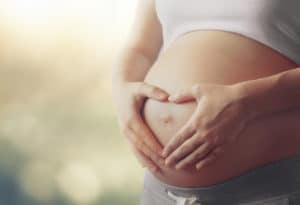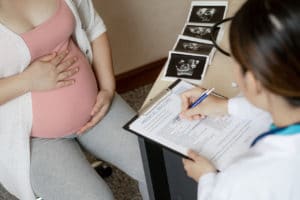Trisomy 21 – for expectant parents this diagnosis often triggers worries and fears and maybe you have also come into contact with the topic. After all, as a pregnant woman you have one wish above all: that your baby is born healthy. Trisomy 21, also known as Down syndrome, is not a disease, but a congenital genetic defect that is based on an incorrect number of chromosomes and usually arises spontaneously after fertilization.
The consequences are physical and mental maldevelopments. About 1 in 600 live births is born with Down syndrome, and an estimated 50,000 people with Down syndrome live in Germany. Below you will learn everything you need to know about trisomy 21.
Table of contents
Trisomy 21 – A Small Chromosome Can Have Big Consequences
Down syndrome got its name from the physician J. Landon Down, who first described the syndrome as a clinical clinical picture in 1866. However, the cause of the syndrome was not discovered until much later. Trisomy 21 is due to a defect in the genetic material, more precisely in the chromosomes, which are the carriers of genetic information and are located in the nuclei of our cells. We speak of trisomy when certain chromosomes in the body cells are not only present twice, as is normally the case, but three times.
In the case of Down syndrome, this is chromosome 21, which is present three times in all body cells, i.e. once too many. Trisomy 21 is therefore a genetic defect, not a disease. The risk of giving birth to a child with trisomy 21 increases exponentially with the age of the mother. However, the higher risk does not only concern trisomy 21, but disabilities in general as well as miscarriages and pregnancy complications. Therefore, all first-time mothers older than 35 years are considered high-risk pregnant women. Surely you have seen a person with Down syndrome. They have a characteristic external appearance. They typically have slanted, wide-set eyes, a round face, a flat nasal bridge, and small feet and hands. Some of these characteristics are also found in Mongolians, which is why Down syndrome used to be called “Mongolism.” Since this term has a racist background, it is no longer used today.
In addition to the typical external appearance, there is usually a reduction in intelligence and delayed development. This is especially noticeable in the first years of life. Children with Down syndrome often have great difficulties with motor skills as well as language development. Body growth is also slowed, which is why affected children usually reach a height that is below average.
How Does Down Syndrome Occur?
As you already know, trisomy 21 is not a disease, but a congenital syndrome based on a genetic defect. However, this genetic defect can occur in different ways. Experts therefore distinguish between free trisomy, translocation trisomy and mosaic trisomy. What exactly these terms mean is explained to you below.
Free Trisomy 21
Free trisomy 21 occurs when there is an error in meiosis. During fertilization, the egg and sperm fuse. The fertilized egg cell receives one set of chromosomes from the father and one set of chromosomes from the mother. Subsequently, the number of chromosomes must be halved. Otherwise, the number of chromosomes would double with each generation. This division process is called meiosis. Free trisomy 21 occurs when the chromosome pair 21 does not divide correctly during meiosis. A distribution error occurs and a supernumerary chromosome results.
Translocation Trisomy 21
In translocation trisomy 21, chromosome 21 is also present in excess, but is attached to another chromosome (usually chromosome 14). This form of trisomy can arise spontaneously, but it can also be hereditary if one parent is a carrier of the translocation.
Mosaic Trisomy 21
Mosaic trisomy is extremely rare. In this form, a supernumerary chromosome 21 is present in only a part of the body cells. The degree of expression of trisomy 21 therefore depends on how many trisome cells are present. If only a small proportion of the body’s cells are affected, the full symptoms of Down syndrome do not necessarily occur.
Note: Free trisomy 21 is present in over 90% of cases. The risk of giving birth to a child with free trisomy 21 increases exponentially with the age of the mother. However, this does not apply to translocation trisomy.
Living And Growing Old With The Extra Chromosome
The life expectancy of people with trisomy 21 has more than tripled in recent decades. Nevertheless, those affected die earlier on average than healthy people. The reason for this is not the gene defect itself, but the health consequences associated with it. Almost half of children with trisomy 21 have a congenital heart defect, which usually affects the heart’s septum. A defect in the septum between the heart chambers and atria causes shortness of breath, recurrent pneumonia and growth disorders. In addition, malformations of the gastrointestinal tract often occur. In some cases, the processing of food becomes difficult or even impossible. The immune system is also often weakened, making sufferers more susceptible to disease and infection.
Effects On Intelligence
It is often the thought of living with an impaired child that scares many parents. In most cases, trisomy 21 leads to mental retardation. What many do not know, however, is that this reduction in intelligence can vary in severity and is usually not as severe as is often claimed. If the affected children receive targeted support at an early stage, they can be well helped to develop their abilities and make the most of their individual potential.
Studying, working, leading an independent life – all this is possible for people with Down syndrome today. It is impossible to predict how a child with trisomy 21 will develop. What can be said, however, is that not all children with Down syndrome are dependent on their parents all their lives, but can manage many things in everyday life on their own.
Diagnosis Down Syndrome
Many expectant parents want to be sure whether their offspring will be born healthy or with a disability. That is why they have so-called prenatal tests, i.e. tests that are carried out before the child is born. If you are worried that your unborn child might have Down syndrome, you can have this checked during pregnancy. However, many tests do not offer 100% certainty and carry risks for mother and child. In addition to prenatal diagnostics, it is also possible to examine the baby for trisomy 21 after birth. This is also called postnatal diagnostics.
Prenatal Diagnostics
Prenatal tests to detect Down syndrome are primarily offered to women from the risk group. You belong to the risk group if you are older than 35 years or have an increased risk of giving birth to a child with Down syndrome (for example, if trisomy 21 was already detected in a previous pregnancy). Both invasive and non-invasive procedures are used in prenatal diagnosis. As a rule, non-invasive procedures are used first, which are more inaccurate but do not pose any health risk to the mother and fetus. If abnormal results are obtained, invasive procedures may be considered to make a definitive diagnosis.
Non-invasive Procedures
Ultrasound (Sonography)
With the help of an ultrasound examination, malformations, such as a flat face or shortened fingers, can be detected that indicate trisomy 21. However, this does not necessarily mean that Down syndrome is actually present. Therefore, this method can also lead to incorrect interpretations.
Triple Test
In the triple test, blood is taken from the pregnant woman. Subsequently, certain parameters are compared with pregnant women in the same biological week of pregnancy. If there are values that deviate from the norm, it may be trisomy 21. However, this test is also not specific for trisomy 21.
Invasive Procedures
Amniocentesis
In a procedure called amniocentesis, amniotic fluid is removed from the amniotic sac. A cell culture is then created with the cells of the fetus and the number and structure of the chromosomes are examined. In this way, it can be clearly determined whether trisomy 21 is present. However, amniocentesis also involves some risks. These include miscarriage, injury to the fetus, and vaginal bleeding and injury. In addition, this procedure is possible from the 14th week of pregnancy at the earliest. Late diagnosis can be very stressful for pregnant women.
Chorionic Villus Sampling
In this procedure, tissue is taken from the placenta to detect any chromosomal changes. For this purpose, the genetic material is also examined in the laboratory. Chorionic villus sampling is possible a few weeks earlier than amniocentesis. Therefore, if the pregnant woman decides to terminate the pregnancy, it can be done in the first trimester without any problems. At a later stage, abortions are associated with greater physical and psychological stress for the pregnant woman. However, tissue removal also increases the risk of miscarriage and can cause infections and vascular injuries.
Postnatal Diagnostics
If trisomy 21 is suspected after the birth of the child, a tentative diagnosis can first be made using Jackson’s (1976) diagnostic index.
For this purpose, 25 symptoms of Down syndrome are used. According to Jackson, these are the 10 main symptoms:
- Brachycephalus (short skull)
- Laterally rising eyelid axes
- Nystagmus (uncontrolled eye tremor)
- Flat nasal bridge
- Narrow palate
- Clinodactyly V (curved fingers)
- Muscular hypotonus (muscle weakness)
- Sandal gap (large distance between first and second toe)
- Folding of the auricle
- Short neck
However, laboratory testing is essential to make a definitive diagnosis. If there is a strong suspicion of trisomy 21, a cell culture is created with the cells of the fetus and a karyogram is created. In the karyogram, all chromosomes of a cell are imaged. In this way, it is possible to check whether chromosome 21 is present in triplicate, i.e. whether trisomy 21 is present.
Can Trisomy 21 Be Cured?
You may now be wondering if trisomy 21 can be treated or even cured. However, despite great advances in molecular genetics, it is not (yet) possible to cure the genetic defect or render the excess chromosome ineffective. However, the secondary diseases from which many children with Down syndrome suffer can be treated very well today. Heart defects and malformations of the gastrointestinal tract can usually be corrected surgically without any problems. Muscles that are often too weak can be strengthened with physiotherapy. In any case, it is important to recognize and treat possible problems of the children at an early stage. Whether hearing problems, vision problems, learning difficulties or motor problems – the earlier children with trisomy 21 are supported and treated, the better they can develop their skills.











1 thought on “Trisomy 21 – Living With Impairment”